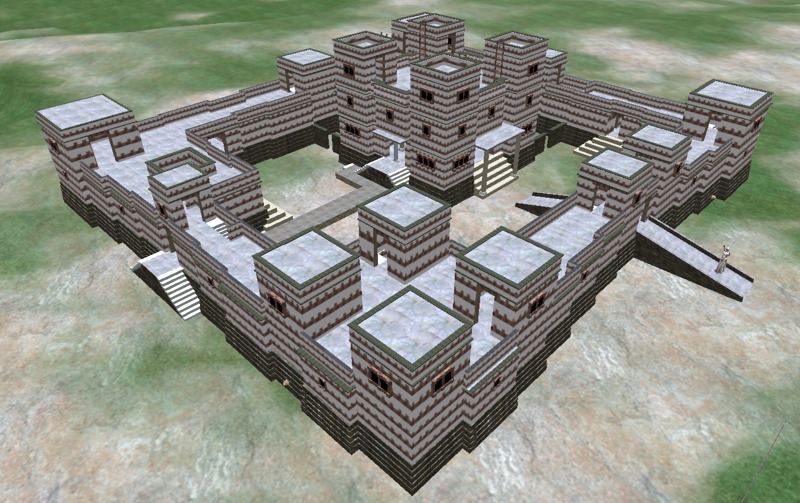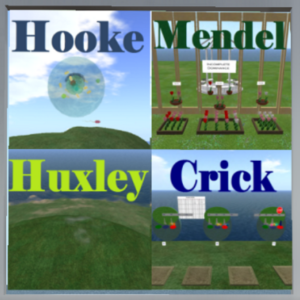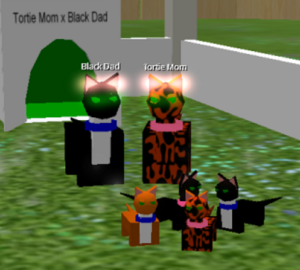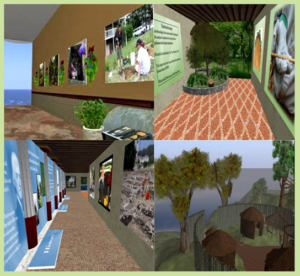
The Science Circle has been a part of the virtual world of Second Life since 2007. Recently, the Science Circle has expanded its reach by creating a grid, Science Circle Foundation, in an adjoining virtual space called Open Simulator (OpenSim). The OpenSim platform is free to use and anyone can set up a grid and experiment with virtual world building. The Science Circle is encouraging its members to use OpenSim for experimental builds of a scientific and educational nature. Today, we will explore the grids created by three of the Science Circle members: Skip Dahlgren, Dr. Mary Anne Clark and Marion Smeltzer.
I asked each scientist to describe their grid and to explain their goals. So, the texts below are quotations from them. Links to their grids and links to further other information are in the References below.
Skip Dahlgren (SL name: Ababrukh Aabye ) – Virtual Abyssinia
Virtual Abyssinia is in the process of being expanded by the addition of an Aksumite palace (ca 4th-6th century CE), set at the Eritrean site known as Metera, containing elements from palaces excavated there as well as at Qohaito, another important Eritrean site, & at Dungur, a site outside of Aksum in Tigrray. Further additions will include the hawulti (stelae) & stone thrones of Aksum, the 9th century church at the Tigrayan monastery Debre Dammo, the port city Adulis, & perhaps the source of the Blue Nile.
Virtual Abyssinia is intended as an archaeological museum, an introduction to the history of an important region which at least twice contained kingdoms that were seen as world powers of their time, & which now are largely forgotten.

I hope to reach students of all ages, especially students of history & archaeology, & more especially those whose primary interest is in Africa. Additionally I hope to reach people in Africa & other parts of the world which were impacted in antiquity by the Abyssinian kingdoms.
I have primarily relied on word of mouth to advertise my build, especially at times when I was scheduled to present tours. I also have saved links to the description of my build on the Science Circle webpage, the informational page describing how to gain access to the Science Circle grid, & the Youtube video of one of my tours, which I give to interested parties. Of course, any publicity provided by Chantal is greatly appreciated.
I have longed for the opportunity to reconstruct my original Virtual Abyssinia, which I built on Second Life thanks to the financial support of.a friend whose departure forced me to abandon the project. The new build on the Science Circle grid on OpenSim is a wonderful opportunity, but access to the cite is limited compared the possibilities if it were on Second Life. I would immediately seize the opportunity to build a new site on SL, but financial limitations prevent me from doing so.
Mary Anne Clark (SL name:Max Chatnoir) – Genetics and Cell Biology
Most of the activities you can see in OpenSim were copied over from Genome Island in Second Life. However, in VIBE, they are spread out and occupy three separate islands. Most of the transmission genetics is on Mendel. Most of the molecular genetics and human genetics is on Crick. The cell biology activities are on Hooke. A fourth island, Huxley, which will focus on genetics and diversity, is still undeveloped.
 At the entrance to Mendel’s Garden Path is an aerial map of the 11 activity areas located along the Garden Path. Three of the stations are: the Monohybrid Cross, the Cattery and the Mixollama Herd. Crick Island is divided into several sectors. Four of these are housed in buildings in different quadrants of the island: Human Genetics, Historical Genetics, Fly Base and the Crick Pavilion. Connecting these structures are Ribosome Row and several Genome Galleries. At the center of Crick Island is Chromosome Hill, which contains scale models of all 24 human chromosomes. The focal center of Hooke Island is two scale models (more or less) of prokaryotic and eukaryotic cells.
At the entrance to Mendel’s Garden Path is an aerial map of the 11 activity areas located along the Garden Path. Three of the stations are: the Monohybrid Cross, the Cattery and the Mixollama Herd. Crick Island is divided into several sectors. Four of these are housed in buildings in different quadrants of the island: Human Genetics, Historical Genetics, Fly Base and the Crick Pavilion. Connecting these structures are Ribosome Row and several Genome Galleries. At the center of Crick Island is Chromosome Hill, which contains scale models of all 24 human chromosomes. The focal center of Hooke Island is two scale models (more or less) of prokaryotic and eukaryotic cells.
 All of these activity areas are interactive and were designed to be used by beginning university or even high school students or just anybody interested in genetics.
All of these activity areas are interactive and were designed to be used by beginning university or even high school students or just anybody interested in genetics.
Marion Smeltzer (SL name: Nova Saunders) – Archaeology
Nova Archaeology Island contains five virtual archaeological experiences based on real life historical
and prehistorical investigations and research. It’s designed as an interactive museum exhibit. While some sections are primarily of interest to researchers and students, the island can be an interesting destination for others looking for a different kind of adventure. The goal, in addition to enhancing the students’ educational experience and research, is to create new ways to present information about archaeology for a general audience. Ultimately, we hope the area will be utilized with more teachers and students as well as the general public. We have marketed this build through functions with the educational groups represented on Second Life and OpenSim to generate interest.
 OK, back to me. You can visit the grids discussed above and future builds sponsored by the Science Circle by following the directions found on the Science Circle website. The link is below in References.
OK, back to me. You can visit the grids discussed above and future builds sponsored by the Science Circle by following the directions found on the Science Circle website. The link is below in References.
OpenSim does not supply a viewer. Their web site lists a number of third-party sources and the most common is Firestorm. I’ve used Firestorm for years with Second Life and the same version of Firestorm used to support Open Sim as well. Recent builds of Firestorm have an additional version, FirestormOS, for OpenSim. This version does also support Second Life but apparently not all the most recent features. I’m using FirestormOS for Second Life and it seems fine to me.
Is OpenSim a competitor to Second Life? This is from the OpenSim web site, “OpenSimulator can be used to simulate virtual environments similar to Second Life™. However, OpenSimulator does not aim to become a clone of the Second Life server platform. Rather, the project aims to enable innovative feature development for virtual environments and the Metaverse at large.” This is exactly how the Science Circle is using OpenSim, as a way for scientists to explore building innovative settings at low cost or basically for free.
References
- OpenSimulator, Project home page.
- OpenSim installation instructions on the Science Circle web site.
- Link to Mr. Dahlgren’s build.
- Link to Dr. Clark’s OpenSim build and to further information.
- Link to Ms. Saunders build.
- OpenSim available viewers.
- Firestorm OpenSim version.
 |
| Visits: 1623304 |

Wonderful review of the builds